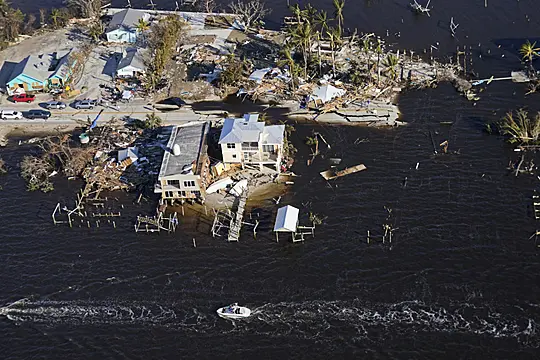Authorities in Florida confirmed several more deaths late on Saturday that raised the state’s death toll from Hurricane Ian to at least 47 fatalities.
A list of the dead compiled by medical examiners in the state and made public reported numerous drowning deaths, victims found submerged or floating in storm waters.
Ian slammed into the southwest Gulf Coast of Florida as a major Category 4 hurricane earlier in the week before crossing the peninsula out over the Atlantic Ocean and then striking the US southeast seacoast as a Category 1 hurricane.
Four other storm-related deaths were reported in North Carolina and three in Cuba.

As of Saturday, more than 1,000 people had been rescued from flooded areas along Florida’s southwestern coast alone, Daniel Hokanson, a four-star general and head of the National Guard, told The Associated Press while airborne to Florida.
On Pine Island, the largest barrier island off Florida’s Gulf Coast, houses were reduced to splinters and boats littered roadways as a volunteer rescue group went door-to-door, asking isolated residents if they wanted to be evacuated. Residents described the horror of being trapped in their homes as water kept rising.
“The water just kept pounding the house and we watched, boats, houses — we watched everything just go flying by,” said Joe Conforti, as he fought back tears.
He said if it was not for his wife, who suggested they get up on a table to avoid the rising water, he would not have made it: “I started to lose sensibility, because when the water’s at your door and it’s splashing on the door and you’re seeing how fast it’s moving, there’s no way you’re going to survive that.”

River flooding posed a major challenge at times to rescue and supply delivery efforts. The Myakka River washed over a stretch of Interstate 75, forcing a traffic-snarling highway closure for a while on Saturday.
While rising waters in Florida’s southwest rivers have crested or are near cresting, the levels are not expected to drop significantly for days, said National Weather Service meteorologist Tyler Fleming in Tampa.
Elsewhere, South Carolina’s Pawleys Island — a beach community roughly 75 miles (115 kilometres) up the coast from Charleston — was among the places hardest hit. Power remained knocked out to at least half of the island on Saturday.
The Pawleys pier was one of at least four along South Carolina’s coast destroyed by battering winds and rain. Meanwhile, the intracoastal waterway was strewn with the remnants of several boat houses knocked off their pilings.







